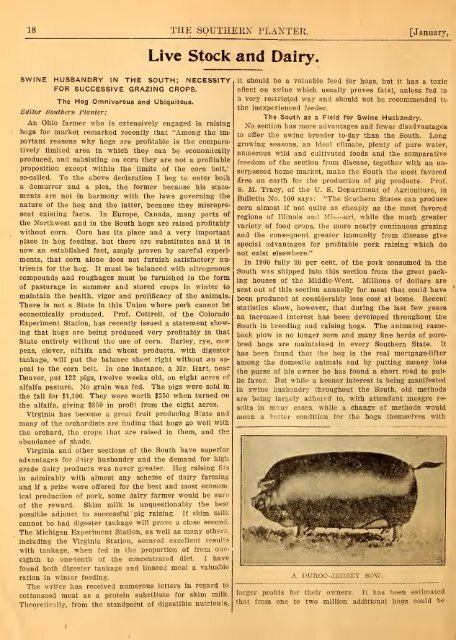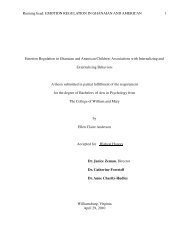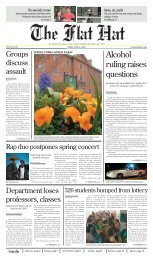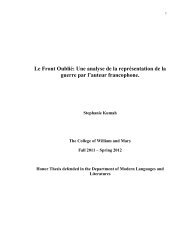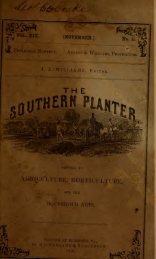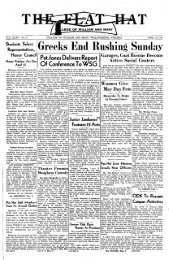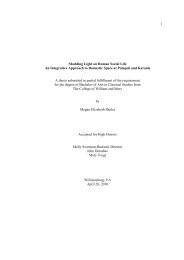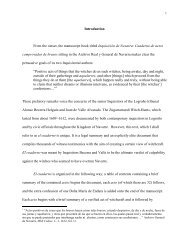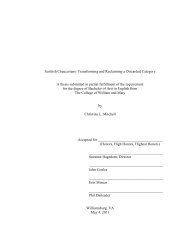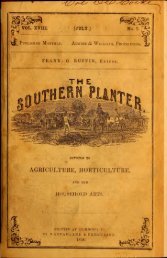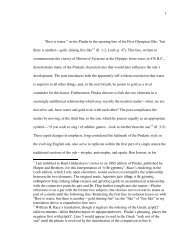Southern planter - The W&M Digital Archive
Southern planter - The W&M Digital Archive
Southern planter - The W&M Digital Archive
Create successful ePaper yourself
Turn your PDF publications into a flip-book with our unique Google optimized e-Paper software.
18 THE SOUTHERN PLANTER. [January,<br />
SWINE HUSBANDRY IN THE SOUTH; NECESSITY<br />
FOR SUCCESSIVE GRAZING CROPS.<br />
<strong>The</strong> Hog Omnivorous and Ubiquitous.<br />
Editor <strong>Southern</strong> Planter:<br />
An Ohio farmer who is extensively engaged in raising<br />
hogs for market remarked recently that "Among the important<br />
reasons why hogs are profitable is the comparatively<br />
limited area in which they can be economically<br />
produced, and subsisting on corn they are not a profitable<br />
proposition except within the limits of the corn belt,'<br />
so-called. To the above declaration I beg to enter both<br />
a demurrer and a plea, the former because his statements<br />
are not in harmony with the laws governing the<br />
nature of the hog and the latter, because they misrepre-<br />
sent existing facts. In Europe, Canada, many parts of<br />
the Northwest and in the South hogs are raised profitably<br />
without corn. Corn has its place and a very important<br />
place in hog feeding, but there are substitutes and it is<br />
now an established fact, amply proven by careful experiments,<br />
that corn alone does not furnish satisfactory nu-<br />
trients for the hog. It must be balanced with nitrogenous<br />
compounds and roughages must be furnished in the form<br />
of pasturage in summer and stored crops in winter to<br />
maintain the health, vigor and prolificacy of the animals.<br />
<strong>The</strong>re is not a State in this Union where pork cannot be<br />
economically produced. Prof. Cottrell, of the Colorado<br />
Experiment Station, has recently issued a statement show-<br />
ing that hogs are being produced very profitably in that<br />
State entirely without the use of corn. Barley, rye, cow<br />
peas, clover, alfalfa and wheat products, with digester<br />
tankage, will put the balance sheet right without -an appeal<br />
to the corn belt. In one instance, a Mr. Hart, near<br />
Denver, put 122 pigs, twelve weeks old, on eight acres of<br />
alfalfa pasture. No grain was fed. <strong>The</strong> pigs were sold in<br />
the fall for $1,100. <strong>The</strong>y were worth $250 when turned on<br />
the alfalfa, giving $850 in profit from the eight acres.<br />
Virginia has become a great fruit producing State and<br />
many of the orchardists are finding that hogs go well with<br />
the orchard, the crops that are raised in them, and the<br />
abundance of shade.<br />
Virginia and other sections of the South have superior<br />
advantages for dairy husbandry and the demand for high<br />
grade dairy products was never greater. Hog raising fits<br />
in admirably with almost any scheme of dairy farming<br />
and if a prize were offered for the best and most econom<br />
ical production of pork, some dairy farmer would be sure<br />
of the reward. Skim milk is unquestionably the best<br />
possible adjunct to successful pig raising. If skim milk<br />
cannot be had digester tankage will prove a close second.<br />
<strong>The</strong> Michigan Experiment Station, as well as many others,<br />
including the Virginia Station, secured excellent results<br />
with tankage, when fed in the proportion of from oneeighth<br />
to one-tenth of the concentrated diet. I have<br />
found both digester tankage and linseed meal a valuable<br />
ration in winter feeding.<br />
<strong>The</strong> writer has received numerous letters in regard to<br />
cottonseed meal as a protein substitute for skim milk.<br />
<strong>The</strong>oretically, from the standpoint of digestible nutrients,<br />
Live Stock and Dairy.<br />
it should be a valuable feed for hogs, but it has a toxic<br />
eflect on swine which usually proves fatal, unless fed in<br />
a very restricted way and should not be recommended to<br />
the inexperienced feeder.<br />
<strong>The</strong> South as a Field for Swine Husbandry.<br />
No section has more advantages and fewer disadvantages<br />
to offer the swine breeder to-day than the South. Long<br />
growing seasons, an ideal climate, plenty of pure water,<br />
numerous wild and cultivated foods and the comparative<br />
freedom of the section from disease, together with an unsurpassed<br />
home market, make the South the most favored<br />
area on earth for the production of pig products. Prof.<br />
S. M. Tracy, of the U. S. Department of Agriculture, in<br />
Bulletin No. 100 says: "<strong>The</strong> <strong>Southern</strong> States can produce<br />
corn almost if not quite as cheaply as the most favored<br />
regions of Illinois and Miscjuri, while the much greater<br />
variety of food crops, the more nearly continuous grazing<br />
and the consequent greater immunity from disease give<br />
special advantages for profitable pork raising which do<br />
not exist elsewhere."<br />
In 1900 fully 9.0 per cent, of the pork consumed in the<br />
South was shipped into this section from the great pack-<br />
ing houses of the Middle-West. Millions of dollars are<br />
sent out of this section annually for meat that could have<br />
been produced at considerably less cost at home. Recent<br />
statistics show, however, that during the last few years<br />
an increased interest has been developed throughout the<br />
South in breeding and raising hogs. <strong>The</strong> animated razorback<br />
plow is no longer seen and many fine herds of purebred<br />
hogs are maintained in every <strong>Southern</strong> State. It<br />
has been found that the hog is the real mortgage-lifter<br />
among the domestic animals and by putting money into<br />
the purse of his owner he has found a short road to pub-<br />
lic favor. But while a keener interest is being manifested<br />
in swine husbandry throughout the South, old methods<br />
are being largely adhered to, with attendant meagre results<br />
in many cases, while a change of methods would<br />
mean a better condition for the hogs themselves with<br />
A DDROC-JEIISEY SOTV<br />
larger profits for their owners. It has been estimated<br />
that from one to two million additional hogs could be


